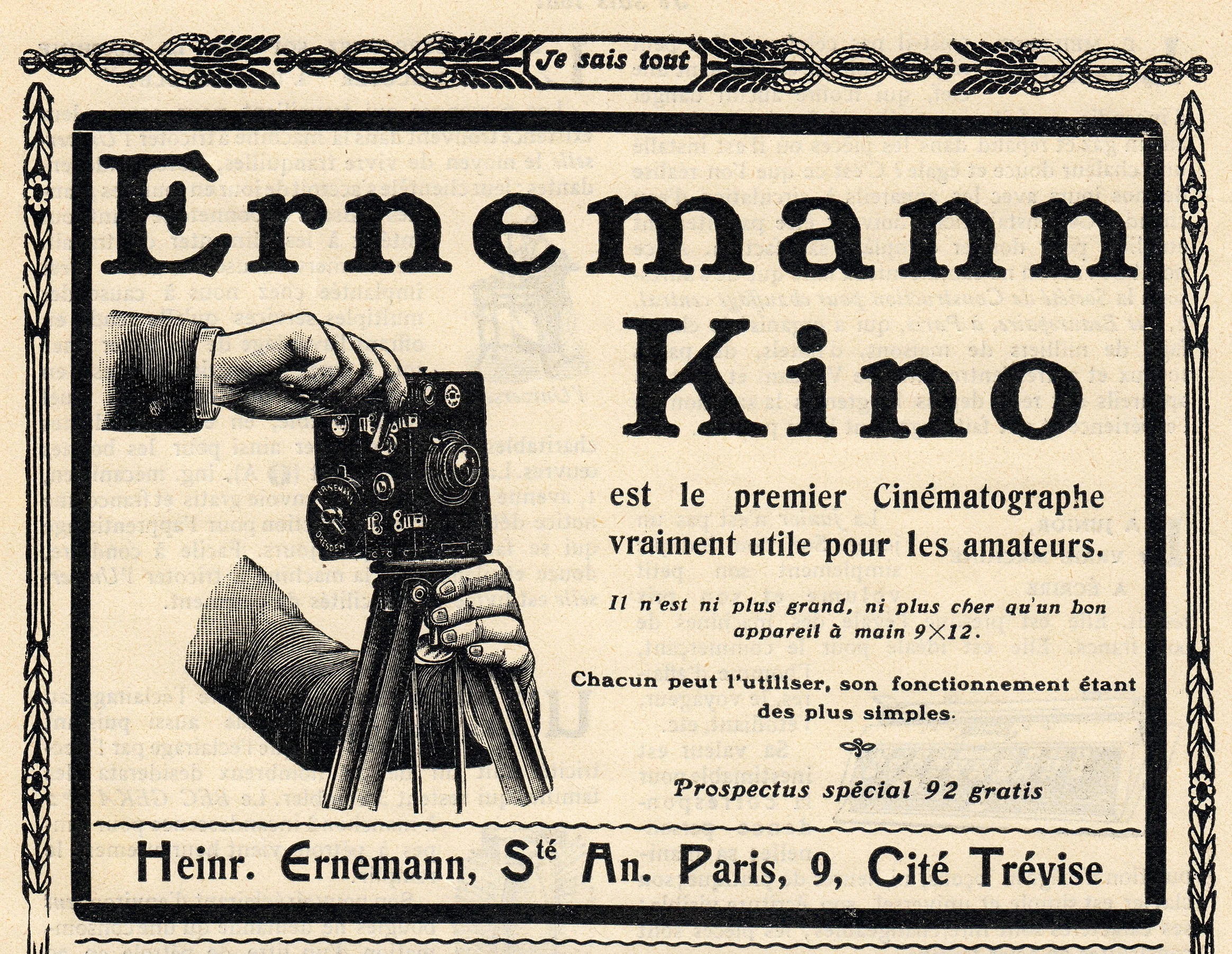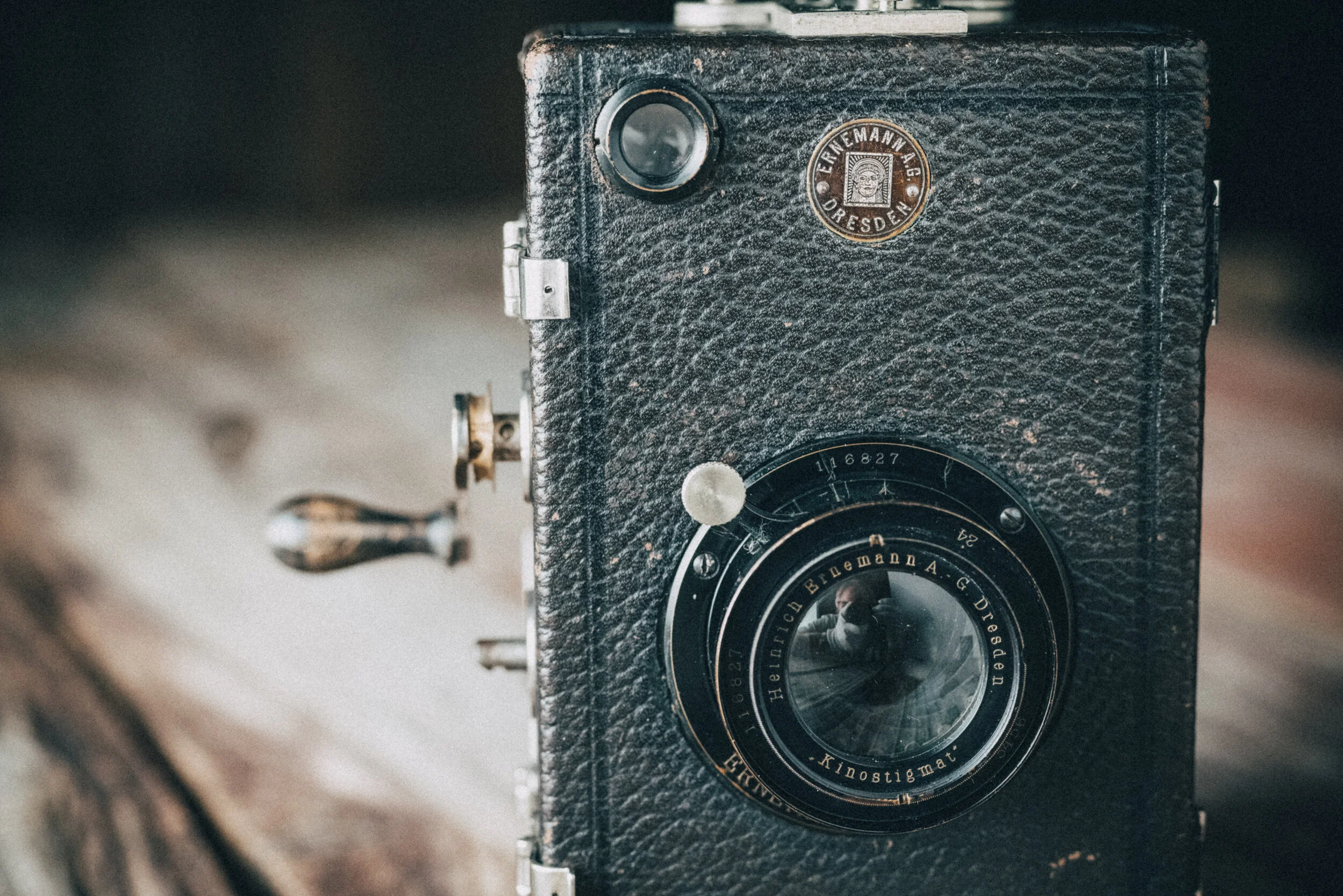Ernemann Kino II
c. 1904 Ernemann Kino II 17.5mm Amateur Cine Camera.
“A masterpiece of precision engineering.”
In 1903, Heinrich Ernemann launched the marketing campaign for his new ‘Kino’ camera, designed specifically for 17.5 mm motion picture film. The Ernemann Kino camera was advertised as Germany’s very first small-gauge camera created exclusively for amateur use, marking a major step forward in making filmmaking technology more accessible to the public.
Ernemann Kino Advertising, 1903
“Ernemann Kino is the first truly useful Cinematograph for amateurs. It is neither larger nor more expensive than a good 9x12 handheld device. Everyone can use it, its operation being very simple.”
Within five years, the Erneman line grew to include the Kino II, an improved version of the original Kino I and the 35mm Normal Kino Model A, a full size wood body hand cranked camera. In 1909 Heinrich Ernemann called his son Alexander back from the U.S. to become technical director and lead the Cinema division. Under Alexander’s leadership, Ernemann became a top maker of cinema cameras, producing many camera and projector models in 17.5mm and 35mm.
“Ernemann Cinema is the most perfect in terms of its performance and the simplest cinematographic apparatus in existence in terms of handling.”
In 1905, when the Kino II was released, competition for the amateur market was intensifying. Both cost and size were critical to success, and on the size front the Kino II was leader of the pact. This compact camera rivals the tiny size of modern “prosumer” cameras today…but the Kino line was introduced nearly 125 years ago…when the film industry was still in its infancy.
The Kino II fits in the palm of your hand.
The 17.5mm centrally perforated film, was very similar to the format used in the earlier Biokam which produced an image size of 16 x 10 mm. The ergonomics were surprisingly good for such a small camera, and it was easy to shoot steady hand held footage with the built-in finder. It even included a spring wound motor in addition to the hand crank, which was unusual for this era. Additionally, the camera functioned as a projector and Ernemann sold films as a companion to the set.
“With all these advantages, the device is so small that you can easily store it in your coat pocket.”
The tiny build is really a marvel to look at, it’s like a shrunk down Pathe Studio camera that literally fits in the palm of your hand. This is one of my favorite cameras. But was it Germany’s first small-gauge camera made exclusively for amateur use?
c. 1906 Ernemann Kino II
A few years earlier a small company in Dresden invented what appears to be nearly identical models and coined the Kino name. It was entrepreneur and inventor Fridolin Kretzschmar who created and sold this 17.5mm film system. His Kretzschmar Kinematograph was first introduced to the public starting in 1902, a full year before Ernemann.
In 1903 Kretzchmar followed up with an improved model of the Kretzschmar-Kinematograph, which was again copied by Ernemann with their ‘Kino II’. Ernemann launched the improved Kino II a few years later with the introduction of its ‘1906 Model’, and although they were essentially the same cameras, Kretzschmar intended his cameras for a more prosumer and professional market rather than home entertainment. Both Kretzschmar machines were sold with a lamphouse to convert the camera into a projector and a printing box to produce positive film in a reversal process, as were the Ernemann models.
We dont know for sure exactly how Ernemann came to produce nearly identical models of the two Kretzschmar cameras, the most likely reason is that the patients were purchased from Kretzschmar prior to shutting down opeartions. But this won’t be the last time Ernemann uses another makers designs. In 1917, they produced a copy of a French made camera from maker Andre Debrie. You can read about their Le Parvo, or its clone, the Ernemann Kino Model E.
Kretzschmar Kinematograph
Kretzschmar Kinematograph c. 1902
This little-known system is the first German-made ‘substandard’ cine camera. The Kretzschmar Kinematograph is identical to the later Ernemann Kino (or Kino I as it became known) which was introduced a year after the Kretzschmar model.
Ernemann Kino I
One year after the introduction of the original The Kretzschmar Kinematograph, Ernemann introduced their Kino model. The Kino camera was initially listed for 150DM in their 1903 catalog, touted as the “Latest achievement of the photographic industry” on the front page.
The positive film is now used to show the living photograph, either in the examination apparatus, in which the images appear enlarged 2 to 3 times when viewed through a magnifying glass, or by means of a projection lamp with acetylene gas lighting, etc., which illuminates the small images Enlarged 75 - 100 times. With stronger light sources, the images can be enlarged up to approx. 6 meters.
The cassettes loaded in the darkroom can be attached to and removed from the apparatus in daylight, any number of cassettes can be used.
Ask for a special brochure!
1903 Ernemann Catalog- Click for larger images
Ernemann Kino II- Serial No. 139 Image Gallery:
REFERENCES:
Instructions for use for the Kretzschmar Kinematograph , Kretzschmar in Dresden [1902]
Instructions for use for the Ernemann Cinema, Heinrich Ernemann [1903]
Der Mechaniker, Year XI (1903), No. 1, Berlin [1903]
Ernemann Cameras Catalog- List No. 91, Heinrich Ernemann [1903]
Ernemann Kino. Model 1906- Liste No. 96, Heinrich Ernemann [1906]
Histoire du Cinématographe de ses origines jus’a nos jours, G.M. Coissac [1925]
Kino-Taschenbuch, Hans Schmidt [1926]
A Technological History of Motion Pictures, Raymond Fielding [1967]
Ariel Cinematographic Register, Peter Ariel [1981]
Ernemann Cameras, Peter Gollner [1995]
Home Movies- A History of the American Industry, 1897-1979, Alan Kattelle [2000]
Jean Desmet and the Early Dutch Film Trade, Ivo Blom [2003]
Tracing 17.5mm Practices in Germany (1902–1908), Martina Roepke [2007]


























